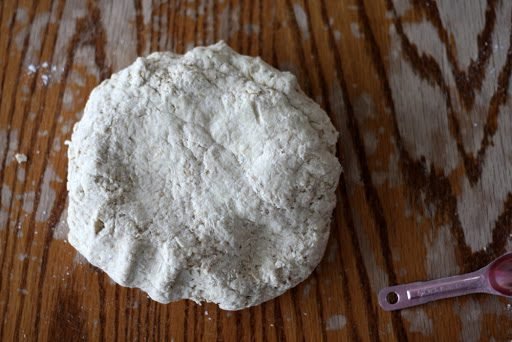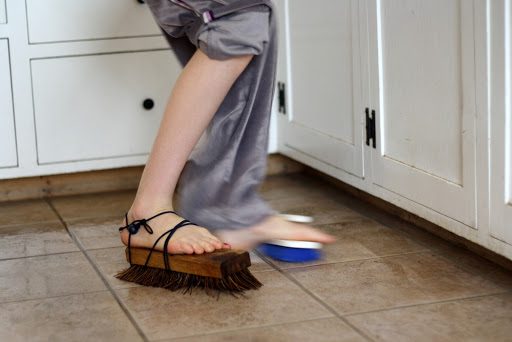Sunday evening, before heading upstairs to bed, I set some rolled oats to soak in buttermilk. The next morning while the snow fell (snow! snow! snow!), I dumped the softened, sour-smelling oats into a large bowl, added some salt, baking soda, and a couple cups of bread flour, and kneaded it all together, dribbling in cold milk as needed.

I pressed and patted the dough into a rough rectangle before slicing it into skinny rectangles and popping them into the oven to bake.

The kids were just finishing up their breakfast of granola and/or oatmeal when the oatcakes came out of the oven.

I split them in half (the cakes, not kids) and slathered some with butter and jelly and others with cream cheese. The kids scarfed them down, and the few that were left over didn’t live beyond lunch.

This was the second time I’d made the oatcakes, so I wasn’t surprised by the kids’ enthusiasm. But when I first tried this recipe about a week ago, I was totally taken aback. There is nothing fancy about these oatcakes. There’s no sugar or fat in them (except for the buttermilk), and I thought they might be turned off by the texture—dense and chewy on the inside, craggy and crusty on the outside.

I couldn’t have been more wrong. The kids loved the chewy bread. And that’s when it hit me—these oatcakes were like bagels!

So I pulled out the cream cheese and the kids went wild. We’ve been hooked ever since.

Oatcakes
Adapted from Bernard Clayton’s New Complete Book of Breads
I used full-fat buttermilk. If using low-fat buttermilk or sour milk, you may want to add a couple tablespoons of melted butter to the dough. Or not…
The original recipe called for 2 ½ cups of flour, but I found that my dough was too dry with just 2 cups of flour. This could be because my buttermilk was so thick—with a thinner milk, more flour may be necessary.
I use sea salt. If using table salt, you may want to cut back to 1 ½ teaspoons.
2 cups rolled oats
1 1/4 cups buttermilk or sour milk
2 teaspoons salt
1 teaspoon baking soda
2 cups bread flour
extra milk, as needed
Stir the oats and buttermilk together, cover with plastic wrap, and let rest at room temperature for 6-8 hours or overnight.
Dump the softened oats into a larger bowl and add the salt, soda, and flour. Using one hand, knead it all together, adding dribbles of milk if the dough feels to dry. (It should be soft and slightly sticky.)
Press the dough into a flat disk or rectangle and cut into desired shapes—triangles, circles, squares, rhombuses, whatever—about 12-14 pieces. Place the oatcakes on a greased baking sheet and bake at 350 degrees for 30-35 minutes.
Split (don’t cut) the fresh cakes in half and top with lots of butter and jelly or cream cheese.
Updated on April 20, 2015: Thanks to a mistake, I made these with 2 cups of oats, 2 cups of yogurt-y milk, 1 teaspoon each of salt and baking soda, and about 1 ½ cups of bread flour. It was easier to mix and turned out delicious.
This same time, years previous: bacon and date scones with Parmesan cheese, dark chocolate cake with coconut milk



12 Comments
Chris
I had the same problem. I made this from the book and searched if there had been a correction. I had to add an additional cup of buttermilk. Jennifer, did you need to add a lot more milk? Did you use quick or whole oats?
Jennifer Jo
In my recipe above, you’ll see I dialed back the amount of flour. I also added extra buttermilk (possibly because I was using thick buttermilk). I used rolled oats.
Anna
I loved this recipe. I used milk plus vinegar because we can't get buttermilk here and it worked fine. thanks for sharing, and by the way your blog is the only one I keep coming back to.
Jennifer Jo
Aw shucks, Anna, thanks! (And I'm glad you liked the oatcakes. I'm craving them again—they'll be our breakfast one day this week for sure.)
Margo
so, I made them. They were good and reminded me strongly me of the pancakes I make (did I mention this already?). I like this as an additional way to use up sour milk and stuff. However, I am going to cut way back on the flour because I had to add a lot of milk. I think I'm going to try only 1 cup flour next time.
KTdid
I'm so hungry for one of these oatcakes right this very minute! It's eleven o'clock at night and I've got no buttermilk. Please help me out here, JJ.
Q.
Zoë
Making these for breakfast tomorrow morning…
Becky
I just found your blog and I'm so glad I did! This recipe looks great! I think I'll give them a try over the weekend. I've been having fun looking through your recipe archive and printing some out to try. 🙂
Mavis
I have enough to do around here without you posting recipes I know I'll have to make.
Thanks a lot JJ.
P.S. I'll let you know how they turn out. 😉
Margo
aha! I've got soured cream in the back of my fridge (to your eternal disbelief, I recall) and I think this is what I will do with it. Once I made Scottish oatcakes which were more like savory cookies – had lard in them. They were good, but I haven't been tempted to make them again.
Anonymous
Why pull apart and not cut? I am thinking these would be good for my husbands lunch pail or a mid-morning snack. Any thoughts on how they would be cold and without butter/cream cheese?
L in Elkton
Jennifer Jo
I think it's kind of the same idea as English muffins—cutting will kind of smoosh the tender inside. However, I think that's only for when they're warm. I cut them when they're cold.
They are very good cold. Chewier, even. But they do need some kind of fat, I think. But cheese and mayo would probably be enough… You may want to roll them thinner if you'll be using them for sandwiches so you get a more even ratio of bread to filling.